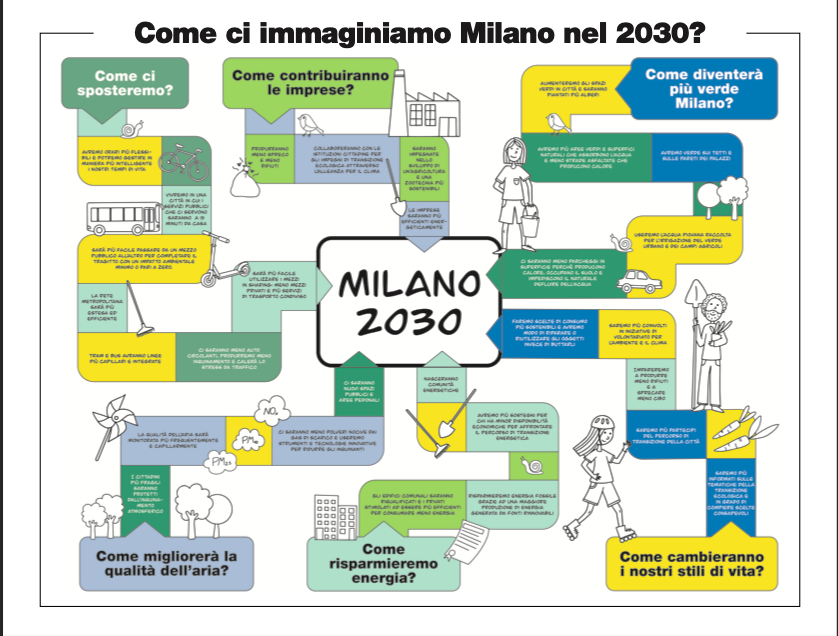How we will live in Milan in 2030

Il Climate change it forced us to rethink the city and act immediately to obtain positive and lasting effects for everyone's quality of life.
In 2019 the Municipality of Milan developed the AIR AND CLIMATE PLAN which defines actions aimed at mitigating the effects and adapting the city to climate change.
The Plan allows us to see how the city is transforming today to embrace the future. Follow the paths to the Milan 2030 in the infographic opposite.
â € ‹â €‹ â € ‹â €‹ â € ‹â €‹ â € ‹
La Milan in 2030 it will be a more sustainable and resilient city, with softer mobility, fewer heat islands, better air quality and more safe green spaces for the benefit of all.
- If you want to lend a hand, find out WHAT YOU CAN DOâ € ‹â €‹ â € ‹â €‹ â € ‹â €‹ â € ‹
The
CLICK BELOW AND DISCOVER THE CITY'S ACTIONS FOR CLIMATE CHANGE AND AIR QUALITY
- We'll have more flexible hours and we will be able to manage our life times more intelligently.
- There will be fewer cars on the road, we will produce less pollution and traffic stress will decrease.
- La metro network it will be more extensive and efficient.
- Trams and buses they will have more capillary and integrated lines.
- It will be easier to switch from one public transport to another to complete the journey with a minimal environmental impact or equal to zero.
- It will be easier to use means of shared transport: fewer private vehicles and more shared transport services.
- We will live in a city where the public services we need will be a 15 minutes from home.
To find out more, read the AIR AND CLIMATE PLAN.
- We'll have green on the roofs and walls of the buildings.
- We will increase green spaces in the city and they will be planted more trees.
- There will be less surface parking and underground which produce heat, occupy soil and prevent the natural flow of water underground.
- We will have more green areas and natural surfaces that absorb water and fewer asphalt roads that produce heat.
- We will use therainwater collected for greenery irrigation urban and agricultural fields.
To find out more, read the AIR AND CLIMATE PLAN
- The air quality will be monitored more frequently and thoroughly
- There will be new public spaces and pedestrian areas.
- Citizens more fragile will be protected from air pollution.
- There will be less harmful dust from exhaust gases and we will use innovative tools and technologies to reduce pollutants.
To find out more, read the AIR AND CLIMATE PLAN
- Businesses will be more efficient in energy consumption.
- They will produce less waste and less waste.
- They will be engaged in the development of more sustainable agriculture and animal husbandry.
- They will collaborate with city institutions for ecological transition commitments, throughAir and Climate Alliance.
â € ‹â €‹ â € ‹â €‹ â € ‹â €‹ â € ‹
To find out more, read the AIR AND CLIMATE PLAN
- - municipal buildings will be redeveloped and private individuals encouraged to be more efficient to consume less energy.
- We will save fossil energy thanks to the increased energy production generated by renewables.
- They will be born energy communities.
- We will have more support for those with less availability economic ones to face the energy transition path.
â € ‹â €‹ â € ‹â €‹ â € ‹â €‹ â € ‹
To find out more, read the AIR AND CLIMATE PLAN
- We'll do it more sustainable consumption choices and we will have the opportunity to repair or reuse objects instead of throwing them away.
- We will learn to produce less waste and waste less food.
- We will be more informed on the issues of the ecological transition and therefore able to carry it out conscious choices.
- We will be the more you participate of the city's transition path.
- We will be more involved in initiatives volunteering for the environment and climate.
â € ‹â €‹ â € ‹â €‹ â € ‹â €‹ â € ‹
To find out more, read the AIR AND CLIMATE PLAN
